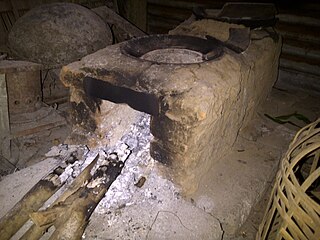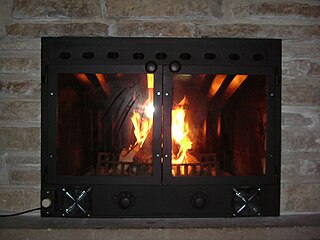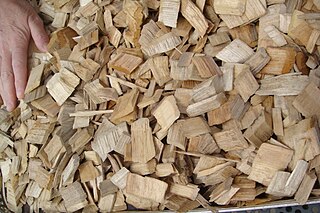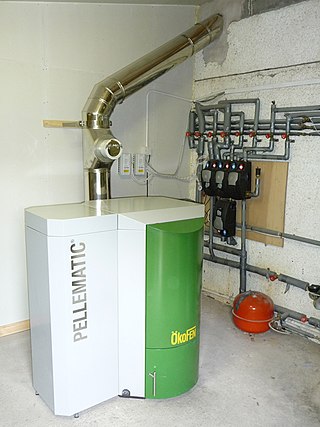Related Research Articles

Solid fuel refers to various forms of solid material that can be burnt to release energy, providing heat and light through the process of combustion. Solid fuels can be contrasted with liquid fuels and gaseous fuels. Common examples of solid fuels include wood, charcoal, peat, coal, hexamine fuel tablets, dry dung, wood pellets, corn, wheat, rice, rye, and other grains. Solid fuels are extensively used in rocketry as solid propellants. Solid fuels have been used throughout human history to create fire and solid fuel is still in widespread use throughout the world in the present day.

A stove or range is a device that generates heat inside or on top of the device, for local heating or cooking. Stoves can be powered with many fuels, such as electricity, natural gas, gasoline, wood, and coal.

Wood fuel is a fuel such as firewood, charcoal, chips, sheets, pellets, and sawdust. The particular form used depends upon factors such as source, quantity, quality and application. In many areas, wood is the most easily available form of fuel, requiring no tools in the case of picking up dead wood, or few tools, although as in any industry, specialized tools, such as skidders and hydraulic wood splitters, have been developed to mechanize production. Sawmill waste and construction industry by-products also include various forms of lumber tailings.

The Energy Policy Act of 2005 is a federal law signed by President George W. Bush on August 8, 2005, at Sandia National Laboratories in Albuquerque, New Mexico. The act, described by proponents as an attempt to combat growing energy problems, changed US energy policy by providing tax incentives and loan guarantees for energy production of various types. The most consequential aspect of the law was to greatly increase ethanol production to be blended with gasoline. The law also repealed the Public Utility Holding Company Act of 1935, effective February 2006.

Pellet fuels are a type of solid fuel made from compressed organic material. Pellets can be made from any one of five general categories of biomass: industrial waste and co-products, food waste, agricultural residues, energy crops, and untreated lumber. Wood pellets are the most common type of pellet fuel and are generally made from compacted sawdust and related industrial wastes from the milling of lumber, manufacture of wood products and furniture, and construction. Other industrial waste sources include empty fruit bunches, palm kernel shells, coconut shells, and tree tops and branches discarded during logging operations. So-called "black pellets" are made of biomass, refined to resemble hard coal and were developed to be used in existing coal-fired power plants. Pellets are categorized by their heating value, moisture and ash content, and dimensions. They can be used as fuels for power generation, commercial or residential heating, and cooking.

A pellet stove is a stove that burns compressed wood or biomass pellets to create a source of heat for residential and sometimes industrial spaces. By steadily feeding fuel from a storage container (hopper) into a burn pot area, it produces a constant flame that requires little to no physical adjustments. Today's central heating systems operated with wood pellets as a renewable energy source can reach an efficiency factor of more than 90%.
Renewable heat is an application of renewable energy referring to the generation of heat from renewable sources; for example, feeding radiators with water warmed by focused solar radiation rather than by a fossil fuel boiler. Renewable heat technologies include renewable biofuels, solar heating, geothermal heating, heat pumps and heat exchangers. Insulation is almost always an important factor in how renewable heating is implemented.
Pelletizing is the process of compressing or molding a material into the shape of a pellet. A wide range of different materials are pelletized including chemicals, iron ore, animal compound feed, plastics, waste materials, and more. The process is considered an excellent option for the storage and transport of said materials. The technology is widely used in the powder metallurgy engineering and medicine industries.

Biomass heating systems generate heat from biomass. The systems may use direct combustion, gasification, combined heat and power (CHP), anaerobic digestion or aerobic digestion to produce heat. Biomass heating may be fully automated or semi-automated they may be pellet-fired, or they may be combined heat and power systems.

Renewable energy in Finland increased from 34% of the total final energy consumption (TFEC) in 2011 to 48% by the end of 2021, primarily driven by bioenergy (38%), hydroelectric power (6.1%), and wind energy (3.3%). In 2021, renewables covered 53% of heating and cooling, 39% of electricity generation, and 20% of the transport sector. By 2020, this growth positioned Finland as having the third highest share of renewables in TFEC among International Energy Agency (IEA) member countries.

Invented in 1896 by Joab R. Donaldson of Oliphant Furnace, Pennsylvania, US, the fireplace insert is a device that can be inserted into an existing masonry or prefabricated wood fireplace. Joab was a 59-year-old coal miner and father of 14 at the time of his patent. He came upon the idea as a means of using coke and incorporating the use of an electric blower to improve the efficiency. The selection of coke and coal tailings as a primary fuel enabled low-income families to heat their Appalachian homes with small-size coal that they could easily dig for themselves in their own backyards.

Woodchips are small- to medium-sized pieces of wood formed by cutting or chipping larger pieces of wood such as trees, branches, logging residues, stumps, roots, and wood waste.

A wood-burning stove is a heating or cooking appliance capable of burning wood fuel, often called solid fuel, and wood-derived biomass fuel, such as sawdust bricks. Generally the appliance consists of a solid metal closed firebox, often lined by fire brick, and one or more air controls. The first wood-burning stove was patented in Strasbourg in 1557. This was two centuries before the Industrial Revolution, so iron was still prohibitively expensive. The first wood-burning stoves were high-end consumer items and only gradually became used widely.

The Biomass Thermal Energy Council (BTEC) is a nonprofit organization in the United States focused on advancing the use of biomass for heat and other thermal energy applications.

Torrefaction of biomass, e.g., wood or grain, is a mild form of pyrolysis at temperatures typically between 200 and 320 °C. Torrefaction changes biomass properties to provide a better fuel quality for combustion and gasification applications. Torrefaction produces a relatively dry product, which reduces or eliminates its potential for organic decomposition. Torrefaction combined with densification creates an energy-dense fuel carrier of 20 to 21 GJ/ton lower heating value (LHV). Torrefaction makes the material undergo Maillard reactions. Torrefied biomass can be used as an energy carrier or as a feedstock used in the production of bio-based fuels and chemicals.
Vermont Sustainable Heating Initiative was a non-profit organization that worked to establish sustainability in the Vermont heating sector. The organization advocated biomass fuels over fossil fuels. In order to promote sustainability and reduce the expense of home heating for impoverished Vermonters, VSHI installed pellet stoves in low-income houses at no cost. VSHI also advocated for the sustainable development of local biomass sources for fuel.
Maine Energy Systems (MESys) was founded in summer 2008 by Les Otten, Dutch Dresser, and others to aid in the transition to alternative energy in the northeastern United States. The company delivers wood pellets in bulk and sells fully automated wood pellet boilers for hydronic heating. MESys has been involved in numerous academic studies, work with political groups concerned with the environmental and economic aspects of residential and light commercial heating, and works with American regulatory bodies concerned with the safety of heating appliances.
The waterside hot water hay pellet furnace is technology that was developed to convert grass and hay into energy that can be used in home heating, also known as grass pellet heating.
Pellet heating is a heating system in which wood pellets are combusted. Other pelletized fuels such as straw pellets are used occasionally. Today's central heating system which run on wood pellets as a renewable energy source are comparable in operation and maintenance of oil and gas heating systems.

A pellet boiler is a heating system that burns wood pellets. Pellet boilers are used in central heating systems for heat requirements from 3.9 kW (kilowatt) to 1 MW (megawatt) or more. Pellet central heating systems are used in single family homes, and in larger residential, commercial, or institutional applications. Pellet boiler systems run most efficiently at full load and can usually be regulated down to 30% of full load. Since the warm up phase of pellet boilers usually takes longer than for oil or gas firing systems, short burning phases have negative effects on the fuel efficiency. In order to improve energy efficiency and reduce harmful emissions, pellet boilers are usually combined with buffer systems, such as insulated water tanks.
References
- ↑ "Who is PFI?". PFI. Archived from the original on 29 October 2013. Retrieved 26 October 2013.
- ↑ “Wood and Pellet Heating,” U.S. Department of Energy
- ↑ “Retailers say pellet stoves are hot item as customers flee from pricey oil heating,” The Business Review (Albany), August 29, 2008
- ↑ ""Pellet Fuels Institute Holds Annual Conference In July," Alternative Energy Retailer, April 25, 2007". Archived from the original on November 6, 2007. Retrieved November 18, 2008.
- ↑ ""Pellet stoves: Economic, friendly alternative to fossil fuel," Alaska Journal of Commerce, December 9, 2007". Archived from the original on May 25, 2009. Retrieved November 18, 2008.
- ↑ "Kangaroo Island Plantation Timbers received $5.5 million grant for its pellet mill in Australia". www.lesprom.com. Retrieved 2021-04-19.